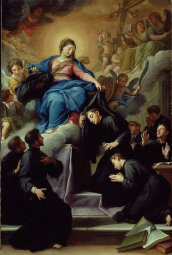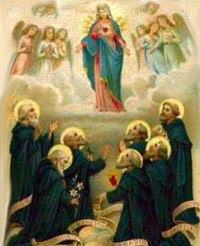
Seven Holy Founders of the Servite Order
Image: Art Institute of Chicago
(EWTN) Between years 1225 and 1227 seven young Florentines joined the Confraternity of the Blessed Virgin–popularly known as the ‘Laudesi’ at a time when the popular City of Italy Florence, was being ripped by political factions, distracted by the heresy of the Cathari and a relaxation of morals even where devotional practices were maintained.
These seven young noblemen of Florence drawn together by friendship and devotion to the Blessed Virgin, gave themselves to common works of charity according to the Friar Servants of Mary and led them to leave their homes and their businesses to form a community outside the city walls.
Before long, finding themselves so much disturbed by the constant visitors of Florence, they decided to withdraw to the deserted slopes of Monte Senario, where the constructed a simple Church, where they followed a life of prayerful seclusion.
As others came to join them, they initially refused to accept new recruits until they were visited one day by the Bishop Ardingo and Cardinal Castiglione, who had heard about their sanctity and was greatly edified but made one adverse criticism:
“You treat yourselves in a manner boarding on barbarity and you seem more desirous of dying to time than living for eternity. Take heed, the enemy of souls often hides himself under the appearance of the angel of light…Harken to the counsels of your superiors.”
The Solitaries gave themselves up to the prayer of light and had a vision of Our Lady, who bore in her hand a black habit while an angel held a scroll inscribed with a title: ‘Servants of Mary’ telling them, she had chosen them to be her servants, wishing them to wear the black habit and to follow the Rule of St. Augustine–From that date, the 13 of April, 1240 they were known as the ‘Servants of Mary’ or Servites.
 The Seven Holy Founders of the Servite Order
The Seven Holy Founders of the Servite Order
Image Courtesy: Da Mihi Animas
Clothed by the Bishop, Buonfigilo being elected their Superior and according to custom, they selected names by which they should forward be known, becoming Brothers Bonfilius, Alexis, Amadeus, Hugh, Sostenes, Manettus and Buonagiunta–By the wish of the Bishop, all except St. Alexis who in his humility begged to be excused, prepared to receive Holy Orders and in due time they were professed and ordained Priests.
The new order which took a form more like that of a Mendicant Friars than that of the monastic orders, increased amazingly and it soon became necessary to construct new houses:
Siena, Pistoia and Arezzo were the first places chosen and subsequently the houses at Carfaggio, the Convent and the Church of the Santissima Annunziata in Florence and the Convent at Lucca were established.
Meanwhile, although the ‘Servants of Mary’ had the approval of their immediate superiors, they had not been recognized by the Holy See, it was only in 1259 that the Order was practically recognized by Alexander IV but not until 1304, that it received the explicit and formal approbation of Pope Benedict XI — Saint Bonfilius had remained as Prior General until 1256 when he asked to be relieved due to his advancing years, he passed away on New Years night 1261
Saint Buonagiunta the youngest of the seven ‘Servants of Mary’ became the second Prior General but not long after his election, he breathed his last in chapel when the ‘Gospel of the Passion’ was being read. Saint Amadeus who had taken charge of the important convent of Carfaggio, returned to Monte Senario to end his days–Saint Manettus, became the fourth Prior General, sending missionaries to Asia, he subsequently retired to make way for Saint Philip Benzi upon whose breast he died.
Saint’s Hugh and Sostenes were abroad–Sostenes in Paris and Hugh had found convents in Germany, they were recalled in 1276 and being attacked by illness, they passed away, side-by-side the same night. Saint Alexis outlived them all and was the only one who survived to see the Order of the ‘Servants of Mary’ fully and finally recognized–he is reported to have passed away at the age of 110.
All seven were Beatified by Pope Clement XI on the 01 December 1717 and Canonized in 1887 by Pope Leo XII
Tweet